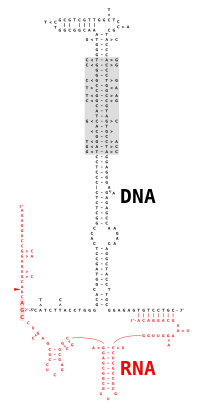
Photo from wikipedia
The evolution of linear chromosomes in eukaryotes poses several challenges for the natural ends of chromosomes, such as misrecognition as DNA damage repair (DDR) sites, DNA degradation, and incomplete DNA… Click to show full abstract
The evolution of linear chromosomes in eukaryotes poses several challenges for the natural ends of chromosomes, such as misrecognition as DNA damage repair (DDR) sites, DNA degradation, and incomplete DNA replication. A solution to these challenges has been the formation of a protective cap structure comprising a tandem array of telomeric repeats and associated proteins. Human telomeres consist of 2 to 20 kb of double-stranded TTAGGG repeats. Telomeres are not blunt-ended but instead terminate with a 100to 150-baselong 30 single-stranded TTAGGG overhang. These overhangs serve two key functions: They provide primers for telomere extension by telomerase and recruit sequence-specific telomeric proteins to cap chromosome ends and to ensure genome stability. Deletion of the overhangs leads to chromosome fusions. The mechanism of telomere end protection has been attributed primarily to the sequestration of the 30 overhang within large duplex loops (t-loops) (1). Another potentially significant factor that could influence the protection of the overhang is that these G-rich repeats spontaneously fold into G-quadruplex (GQ) structures (2). In vitro studies have shown that GQ formation of single-stranded telomeric DNA reduces access of several proteins that target these sites (3, 4), raising the possibility that GQ formation suppresses unwanted DDR or degradation of these overhangs. However, how these long overhangs fold into a complex array of GQ structures and how GQ formation affects the accessibility of single-stranded telomeric sites are not well understood. Most of the previous in vitro work focused on DNA substrates long enough to form a single GQ. However, telomeric overhangs can form an array of more than 10 GQ structures, and these GQs can dynamically fold, unfold, and alter their conformation. In PNAS, Shiekh et al. used the single-molecule FRET-PAINT (F€ orster resonance energy transfer-point accumulation for imaging in nanoscale topography) method to investigate the accessibility of long, single-stranded telomeric DNA (5). In GQs, four guanines pair by Hoogsteen hydrogen bonding to form a planar tetrad. GQ folding requires at least four tandem GGGXXX (X refers to any base) repeats and stabilization of the central cavity by monovalent cations. Although the ability of guanine-rich oligonucleotides to fold into tetrameric structures has been known for decades, studies in GQ formation had been mostly limited to in vitro, and their physiological significance remained elusive. This view started to change when GQ formation was shown to down-regulate the transcription of several oncogenes (6). The development of antibodies that target DNA GQ structures also enabled the visualization of GQ structures in the genome of mammalian cells (7). We now know that GQs are enriched at promoters of multiple genes and play a role in the regulation of gene expression (8). GQs are also enriched at telomeres, but their precise role in telomere biology remains to be demonstrated. The intermolecular GQs that form at the double-stranded telomeric DNA may serve as a major obstacle to the replication of telomeric DNA, and resolving these structures requires helicase activity (9). The intramolecular GQs that form at the overhang may reduce the accessibility of single-stranded telomere binding proteins or contribute to the protection of telomere ends against DDR signals. Recent in vitro studies started to shed light on how telomeric overhangs fold into GQ structures. A long telomeric overhang can fold into multiple heterogenous GQ conformations flanked with unfolded regions (10). Due to the scarcity of direct approaches, it remains unclear whether neighboring GQs interact with each other and whether the sequences between folded GQs become accessible to telomere-binding proteins. Shiekh et al. (5) studied the accessibility of telomeric overhangs by using FRET-PAINT, which combines single-molecule FRET with DNA-PAINT. They immobilized a model telomeric DNA that terminates with 4 to 28 repeats of a TTAGGG overhang (Fig. 1, Left). The DNA is labeled with a FRET donor at the junction between single-stranded and double-stranded (ss/ds) telomeric DNA. DNA-PAINT uses an acceptor-labeled peptide nucleic acid (PNA) probe complementary to the G-tracts at the overhang. These PNA probes are seven nucleotides in Fig. 1. Single-molecule observation of GQ folding and accessibility of telomeric overhangs. A model telomeric substrate with a long overhang is immobilized to a glass surface. (Left) The overhang spontaneously folds into multiple GQs and the available sites between adjacent GQs are targeted with short complementary PNA. The FRET signal between PNA probes and the duplex DNA reveals the spatial distribution of accessible sites. (Middle) The accessible sites can be targeted with single-stranded telomeric binding proteins, such as POT1 and RPA. (Right) Tethering of POT1 to the duplex DNA via the rest of the shelterin complex may enable POT1 to antagonize the binding of PNA probes or proteins that target the overhang.
Journal Title: Proceedings of the National Academy of Sciences of the United States of America
Year Published: 2022
Link to full text (if available)
Share on Social Media: Sign Up to like & get
recommendations!